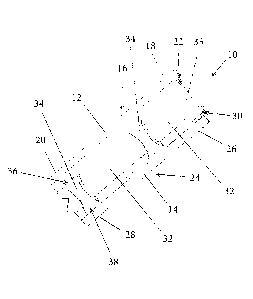Une partie des informations de ce site Web a été fournie par des sources externes. Le gouvernement du Canada n'assume aucune responsabilité concernant la précision, l'actualité ou la fiabilité des informations fournies par les sources externes. Les utilisateurs qui désirent employer cette information devraient consulter directement la source des informations. Le contenu fourni par les sources externes n'est pas assujetti aux exigences sur les langues officielles, la protection des renseignements personnels et l'accessibilité.
L'apparition de différences dans le texte et l'image des Revendications et de l'Abrégé dépend du moment auquel le document est publié. Les textes des Revendications et de l'Abrégé sont affichés :
| (12) Demande de brevet: | (11) CA 3090260 |
|---|---|
| (54) Titre français: | ELEMENT DE CONSTRUCTION ISOLE |
| (54) Titre anglais: | INSULATED CONSTRUCTION MEMBER |
| Statut: | Demande conforme |
| (51) Classification internationale des brevets (CIB): |
|
|---|---|
| (72) Inventeurs : |
|
| (73) Titulaires : |
|
| (71) Demandeurs : |
|
| (74) Agent: | C6 PATENT GROUP INCORPORATED, OPERATING AS THE "CARBON PATENT GROUP" |
| (74) Co-agent: | |
| (45) Délivré: | |
| (22) Date de dépôt: | 2020-08-17 |
| (41) Mise à la disponibilité du public: | 2022-02-17 |
| Licence disponible: | S.O. |
| Cédé au domaine public: | S.O. |
| (25) Langue des documents déposés: | Anglais |
| Traité de coopération en matière de brevets (PCT): | Non |
|---|
| (30) Données de priorité de la demande: | S.O. |
|---|
An insulated construction member has a first wooden rail and a second wooden
rail. The second wooden rail is positioned in parallel spaced relation to the
first wooden rail.
This parallel spaced relation creates a thermal break between the first wooden
rail and the
second wooden rail. A series of planar wooden connectors are positioned at
spaced intervals
along the length of the first wooden rail and the length of the second wooden
rail. Each of
the planar wooden connectors extends across the thermal break between the
first wooden rail
and the second wooden rail. A polymer insulation is positioned between the
first wooden
rail and the second wooden rail completely filling the thermal break. The
polymer insulation
encapsulates the series of planar wooden connectors, with the polymer
insulation being
reinforced by the series of planar wooden connectors.
Note : Les revendications sont présentées dans la langue officielle dans laquelle elles ont été soumises.
Note : Les descriptions sont présentées dans la langue officielle dans laquelle elles ont été soumises.

2024-08-01 : Dans le cadre de la transition vers les Brevets de nouvelle génération (BNG), la base de données sur les brevets canadiens (BDBC) contient désormais un Historique d'événement plus détaillé, qui reproduit le Journal des événements de notre nouvelle solution interne.
Veuillez noter que les événements débutant par « Inactive : » se réfèrent à des événements qui ne sont plus utilisés dans notre nouvelle solution interne.
Pour une meilleure compréhension de l'état de la demande ou brevet qui figure sur cette page, la rubrique Mise en garde , et les descriptions de Brevet , Historique d'événement , Taxes périodiques et Historique des paiements devraient être consultées.
| Description | Date |
|---|---|
| Inactive : Lettre officielle | 2024-03-28 |
| Inactive : Lettre officielle | 2023-08-15 |
| Inactive : Lettre officielle | 2023-08-15 |
| Demande visant la révocation de la nomination d'un agent | 2023-07-25 |
| Demande visant la nomination d'un agent | 2023-07-25 |
| Exigences relatives à la révocation de la nomination d'un agent - jugée conforme | 2023-07-25 |
| Exigences relatives à la nomination d'un agent - jugée conforme | 2023-07-25 |
| Exigences quant à la conformité - jugées remplies | 2022-09-09 |
| Demande publiée (accessible au public) | 2022-02-17 |
| Inactive : Page couverture publiée | 2022-02-16 |
| Demande visant la révocation de la nomination d'un agent | 2022-01-12 |
| Demande visant la nomination d'un agent | 2022-01-12 |
| Exigences relatives à la nomination d'un agent - jugée conforme | 2022-01-12 |
| Exigences relatives à la révocation de la nomination d'un agent - jugée conforme | 2022-01-12 |
| Inactive : CIB en 1re position | 2020-11-15 |
| Inactive : CIB attribuée | 2020-11-15 |
| Inactive : CIB attribuée | 2020-11-15 |
| Inactive : CIB attribuée | 2020-11-15 |
| Exigences de dépôt - jugé conforme | 2020-08-28 |
| Lettre envoyée | 2020-08-28 |
| Demande reçue - nationale ordinaire | 2020-08-17 |
| Inactive : Pré-classement | 2020-08-17 |
| Déclaration du statut de petite entité jugée conforme | 2020-08-17 |
| Inactive : CQ images - Numérisation | 2020-08-17 |
| Représentant commun nommé | 2020-08-17 |
Il n'y a pas d'historique d'abandonnement
Le dernier paiement a été reçu le 2023-07-25
Avis : Si le paiement en totalité n'a pas été reçu au plus tard à la date indiquée, une taxe supplémentaire peut être imposée, soit une des taxes suivantes :
Les taxes sur les brevets sont ajustées au 1er janvier de chaque année. Les montants ci-dessus sont les montants actuels s'ils sont reçus au plus tard le 31 décembre de l'année en cours.
Veuillez vous référer à la page web des
taxes sur les brevets
de l'OPIC pour voir tous les montants actuels des taxes.
| Type de taxes | Anniversaire | Échéance | Date payée |
|---|---|---|---|
| Taxe pour le dépôt - petite | 2020-08-17 | 2020-08-17 | |
| TM (demande, 2e anniv.) - petite | 02 | 2022-08-17 | 2022-08-16 |
| TM (demande, 3e anniv.) - petite | 03 | 2023-08-17 | 2023-07-25 |
Les titulaires actuels et antérieures au dossier sont affichés en ordre alphabétique.
| Titulaires actuels au dossier |
|---|
| BRANDON FERGUSON |
| Titulaires antérieures au dossier |
|---|
| S.O. |